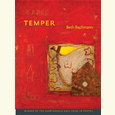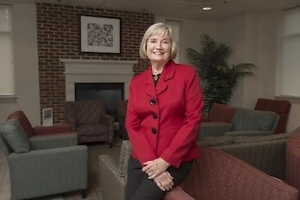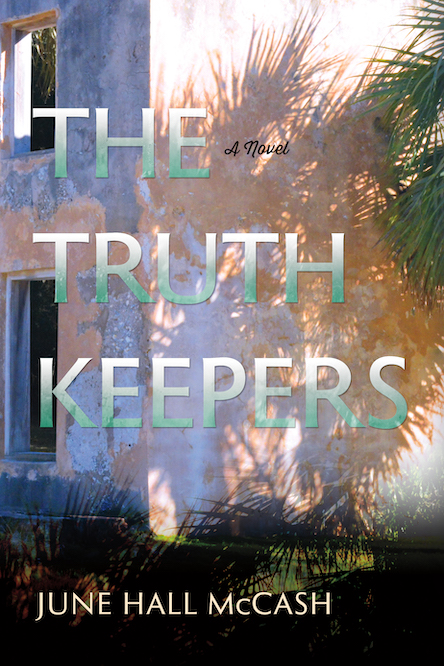Holding On to Beauty
Adriana Trigiani talks with Chapter 16 about her grandparents, her new novel, and how love and creativity find expression in writers—and in the rest of us
Adriana Trigiani’s newest historical novel, The Shoemaker’s Wife, explores the complex inward and outward journeys we take to prepare ourselves for love. The book follows Ciro and Enzo, a young couple who meet during the first years of the twentieth century in the spectacularly beautiful but impoverished Italian Alps. They seem so close, so destined for each other, but circumstances, the missteps of youth, and (no small wrinkle) World War I all conspire to separate them as they journey from Italy to other opportunities abroad.
While the book is constructed as a novel—with an intriguing split narrative that moves between Enza’s journey and Ciro’s—it is in fact an exhaustively researched account of the lives of Trigiani’s own grandparents. Ciro was a shoemaker-craftsman. Enza was a dressmaker of such artistry that she worked for years in the costume shop of the Metropolitan Opera, sewing for Enrico Caruso, the great superstar tenor. Trigiani’s legions of fans and those fascinated by immigrant literature and opera lovers will welcome The Shoemaker’s Wife.
Prior to her Nashville appearance, Trigiani answered questions from Chapter 16 via email about the challenges of writing a biographical novel.
Chapter 16: In preparing to write this lush novel of your grandparents’ long, complex courtship, how did the research differ from that of your other books? Did you alter any aspects of the story to accommodate the demands of a novel—or out of respect for family members?
 Adriana Trigiani: This novel took many years to research and then more to write. My mother’s memories were key to the timeline of the story. I am lucky to live in New York City, where I could walk the streets of Hoboken and Little Italy, go to the Metropolitan Opera, and feel as best I could what it might have been like to live and work here at the turn of the last century. I went to my grandparents’ hometowns in Italy several times and walked where they walked and stood where they stood and felt them there. There are too many details to share here, but there were so many things that I came across that filled me with emotion, that those discoveries could not help but make it into the novel.
Adriana Trigiani: This novel took many years to research and then more to write. My mother’s memories were key to the timeline of the story. I am lucky to live in New York City, where I could walk the streets of Hoboken and Little Italy, go to the Metropolitan Opera, and feel as best I could what it might have been like to live and work here at the turn of the last century. I went to my grandparents’ hometowns in Italy several times and walked where they walked and stood where they stood and felt them there. There are too many details to share here, but there were so many things that I came across that filled me with emotion, that those discoveries could not help but make it into the novel.
I would say that this book differed from previous novels because I had the benefit of having written so many before this one. I had hoped that I would eventually acquire the skill set and the determination to write The Shoemaker’s Wife, and I felt the moment was now to bring this to my readers. Of course I altered the story; I let my imagination guide me. For example, my grandmother was a big Enrico Caruso fan and also a couturier, so I put her in the costume shop of the Metropolitan Opera where she made Caruso’s costumes. I think if she were still here, she would get a kick out of that. I took copious notes of our conversations when I visited her after college (I would go up to northern Minnesota and visit her once a year, every year until she died). So many things she told me I never wanted to forget—like the fact that she and my grandfather were deeply in love when they married. Many of the young couples who married back in 1920 were in arranged marriages. She wanted me to understand that she chose him and he chose her.
Chapter 16: Repeatedly Ciro and Enzo come close and then are drawn apart, an elaborate courtship dance that recalls some classic works of fiction, like the American epic poem Evangeline, or the classic Italian masterpiece, The Betrothed (I Promessi Sposi). In telling the story of your grandparents’ life, were you consciously shaping it within this literary tradition, or did the “epic” quality of your heroes’ very human story simply emerge from the story itself?
Trigiani: You pay me a huge compliment in your question. I did not think of this story in terms of great literature that came before, but as a story of a dressmaker. I thought about my grandmother’s ability as a seamstress—and how she designed garments in a classic way, and then would pull a particular detail to delight the customer. It could be a simple velvet collar, or a satin lining in the pockets, or a peek of tulle around a hem. You’ll notice that I often pulled a single sentence before a particular scene to either set up the emotions or give an overview. This was really an homage to my grandmother’s sense of detail. I wanted the novel to have a particularity of style in the unveiling of the story.
Chapter 16: The Shoemaker’s Wife has a split narrative, alternating between Enza’s and Ciro’s point of view. Creating two voices, not to mention keeping an even narrative pace despite the interruptions, can be a real challenge for a writer. How did you deal with those challenges?
Trigiani: To be honest, I fretted about this and wondered if I had it in me to achieve an effortless give and take from the various points of view—including the authorial voice which sometimes laced through the end of a scene to let the reader know that what had transpired had eternal consequences. I dealt with the challenge, hopefully, by meeting it. In my imagination, anything is possible—which is why I still think that someday, I will be able to join the Ice Capades, even though I’ve never worn a pair of ice skates.
Chapter 16: How does The Shoemaker’s Wife reflect some of the themes of your Valentine series?
 Trigiani: I’m always turning over the same rock. I’m interested in why we love whom we choose to love and how we survive by the labor of our own hands. It’s always love and work, as themes, that intrigue, fascinate, and drive me. The Valentine series is about a family business. It’s the contemporary story of a family who inherited a shoemaking business from 1903. I guess The Shoemaker’s Wife is the story of the immigrants who came over and started the businesses and built the worlds and the life the subsequent generations enjoy. Craftsmanship is a big theme with me because I don’t want to forget how skilled and artful my grandparents were at their work. My grandmother gave me a nightgown that her mother had made for her, and I have it still. The stitches are practically invisible, that’s how skilled she was. I try to write about those skills so they will never be forgotten.
Trigiani: I’m always turning over the same rock. I’m interested in why we love whom we choose to love and how we survive by the labor of our own hands. It’s always love and work, as themes, that intrigue, fascinate, and drive me. The Valentine series is about a family business. It’s the contemporary story of a family who inherited a shoemaking business from 1903. I guess The Shoemaker’s Wife is the story of the immigrants who came over and started the businesses and built the worlds and the life the subsequent generations enjoy. Craftsmanship is a big theme with me because I don’t want to forget how skilled and artful my grandparents were at their work. My grandmother gave me a nightgown that her mother had made for her, and I have it still. The stitches are practically invisible, that’s how skilled she was. I try to write about those skills so they will never be forgotten.
Chapter 16: Anti-immigrant prejudice is well known (both in the time of your novel and in the present day), but you haven’t sugar-coated the fact that some immigrants didn’t hesitate to take advantage of others, even those of their own ethnicity. For example, Enza’s distant relatives in Hoboken are quite willing to exploit her. Can you speak to this phenomenon and how it played out in the immigrant experience?
Trigiani: Sometimes the downtrodden become bullies because they grow weary of their own circumstances. It doesn’t justify the bad behavior or excuse it, but it does provide it a context that bears examination. Anna Buffa would never think she was cruel to Enza; she would think that she was generous and accommodating. Anna knows she feels anger, but she doesn’t think that anger is unjustified. In her mind, she is training her immigrant cousin to run a household and be useful. She is actually helping the person she is abusing. You see where I’m going here. I don’t think this is so much about ethnicity, but specificity of character. I can show you many acts of kindness in the novel among the Italians, but it doesn’t mean that we aren’t also capable of the lesser human traits.
Chapter 16: There are challenges in bringing a well-known historical figure like Enrico Caruso into a novel. There are legions of Caruso and opera fans ready to pounce on errors of fact. Was this possibility at all intimidating? What were your best research sources?
Trigiani: I wasn’t intimidated; I was enthralled. Caruso is one of those artists who would have been great in any era he was born in. He was a natural. My best sources for researching Caruso were the archives at the Metropolitan Opera. I traced Caruso’s career steps through meticulous research of his benefactor, Otto Kahn. There are so many photographs, small snippets of film, and of course the recordings. You can really devise a full-bodied character from listening to Caruso; every hue and shade of his personality comes through in his music. One of my favorite moments in the novel is when the spotlight hits him on the stage, and he opens his arms to the audience. This is a man who loved his work. Reveled in it. Had the vision to record it for posterity. He genuinely loved people. He was a consummate entertainer and a keen businessman. What’s not to love about that combo?
Chapter 16: You are one of a group of Appalachian writers, including Barbara Kingsolver and Silas House, who have spoken out against mountaintop-removal mining. What role do you feel the literary community can play in addressing the social, political, and environmental issues of this region?
Trigiani: Barbara Kingsolver is our greatest living American novelist. I was so thrilled to meet her and tell her so. She is so brilliant that just standing near her makes a person smarter simply by proximity. Silas House is a total original and a great writer. He is a thinker, but he also possesses a breadth of spirit and heart that is something to behold. Barbara and Silas care deeply about the sanctity of the earth and the treasure we have been handed by simply being born. They are stewards of the land. They also know what I know—having grown up in southwest Virginia, we honor, know, and love coal miners. We admire their skills, their sacrifices and the great contribution they make to providing energy for our lives. The lamps we read by are lit because they go down in the earth and mine the coal that powers electricity. These are facts.
The role the literary community plays in addressing the issues of the region are the same as they have always been. Art is the emotional landscape of a culture. We will try to express, always, what something feels like and why it matters. Further, we will share that knowledge in story, song, and manifesto. We hold beauty, nature, and context as sacred. It’s our job to police every leaf, branch, and rock because an artist never knows where he or she will find inspiration. Our goal is to hold on to beauty, and in so doing, find truth. We’re also, in our own various ways, problem solvers. We think there’s a way to have it all, the lamp lit and the mountain preserved. It’s just in us to think anything is possible.
[This article originally appeared on April 9, 2012. It was updated on October 23, 2015, with new event information.]
Pamela Schoenewaldt is the author of When We Were Strangers. Adriana Trigiani will discuss The Shoemaker’s Wife at the Nashville Public Library on April 18 at 6:15 p.m. Click here for details.





